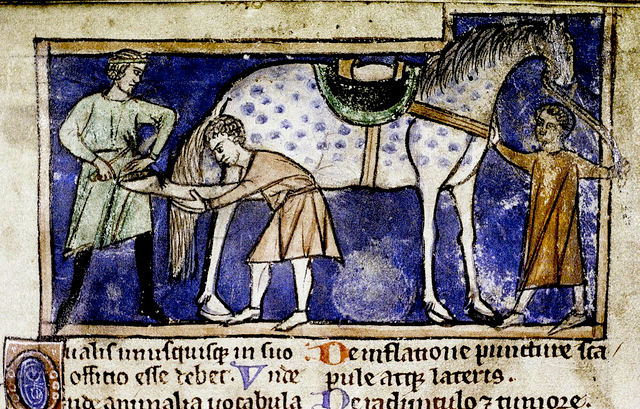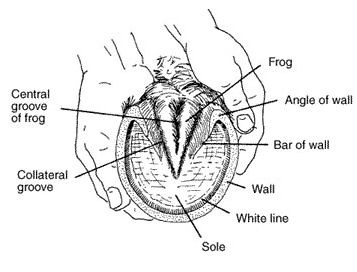Horsemanship Level 4: Foot and Shoeing pt II
For the first part of this topic we looked at the external structures of the foot and their functions. This week we'll address the pros and cons of leaving a horse barefoot versus shod, and when to shoe or re-shoe.
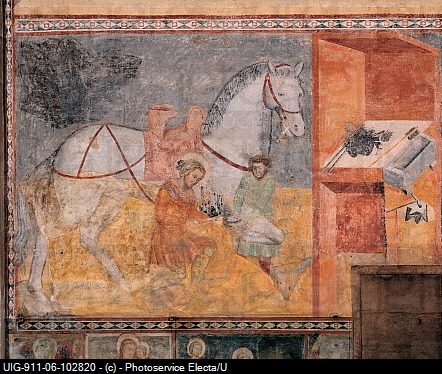
Horseshoes in History
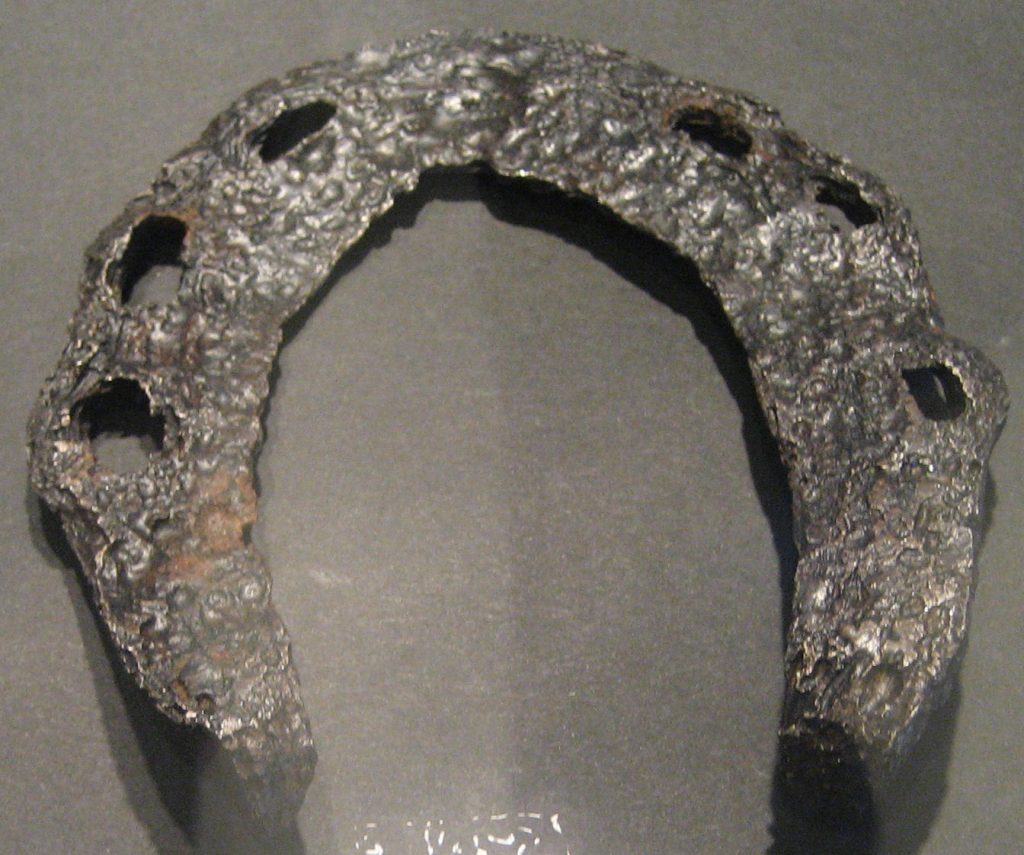
Millions of years of natural selection have designed the equine hoof to function beautifully on the dry grassy plains on which they evolved. Wild horses gallop and trot only for brief stretches, choose smooth terrain for themselves, and carry no burdens other than their own weight. However, as soon as humans domesticated horses they found the need to protect their animals' hooves from the increased burden, speed, and hours of work demanded of them.
Early foot protection was in the form of leather 'sandals', similar to modern hoof boots, made of leather, sometimes with bronze or iron reinforcement on the sole. Four bronze shoes found in an Etruscan tomb dating to 400 BCE seem to have nail holes, but the earliest written record of nailed shoes doesn't occur until 900 CE. It is commonly believed Britons introduced horseshoes to the Romans sometime after 100 CE. But any way you look at it, we have been nailing shoes to horses' hooves for a very long time.
Note: you do not need to know the history of horseshoes for your Level 4 test. This part has been brought to you for interest's sake only!
The Benefits of Barefoot
As discussed in part I of this topic, the hoof is a complex and dynamic structure that interacts with the ground to provide circulation, proprioception, and traction for the horse. That means, when a horse is barefoot:
- the wall expands and contracts with each stride, circulating blood. This keeps the living lamellar tissue behind the walls healthy and returns blood to the legs.
- the frog comes into contact with the ground, providing shock absorbtion and tactile information.
- the sharp wall, cupped sole and rubbery frog all provide traction.
- the shallower profile of a bare foot, along with its ability to expand and contract, allows the hoof to naturally expell dirt and snow during exercise, keeping it free of hard objects and microbe-breeding mud.

When a hard shoe is nailed to the hoof:
- the foot can no longer expand and contract to provide circulation,
- the frog makes less contact with the ground, depriving the horse of proprioception and imparting most of the impact of the stride to the hard wall,
- traction is limited to the small surface of the metal shoe, which becomes slippery on wet grass,
- mud, stones, and ice are far more likely to pack into the hoof creating further traction issues and making it harder to keep clean,
- the horse is more prone to injury by the hard shoe from brushing (hitting the side of one leg with the other), over-reaching (hitting the front heel with the hind hoof), or simply stepping on himself during hauling.
When Shoes are Needed
With all the benefits of keeping a horse barefoot and the drawbacks of shoes, it's hard to see why one would shoe a horse at all. However, shoes are often necessary when:
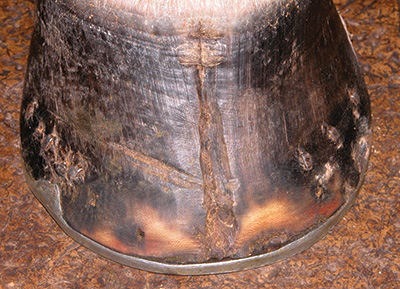
- the footing a horse works or is kept on wears the foot too quickly, or causes sensitivity and bruising on bare hooves.
- the horse is prone to developing cracks, chips, or flares in the wall due to terrain or work.
- the horse's natural hoof conformation is poor: a thin-soled, flat-footed, narrow- heeled horse may be fine in the pasture, but need the support of shoes when bearing a rider's weight.
- corrective shoeing is needed to ameliorate conditions such as laminitis, contracted heels, injuries etc.
- the extra traction of removable studs which can be screwed into shoes for roads or competition is desired.
When to Re-shoe
The hoof continues to grow when it is shod, and so shoes must be removed to allow for trimming at the same intervals as the bare foot. In addition, shoes should be replaced or re-set when
- the clenches (parts of the nail that protrude through the outer wall of the hoof) have popped up and are no long flush with the hoof.
- the hoof is over-long, has grown past the edges of the shoe, or is out of shape.
- the shoe is loose or sitting crooked on the foot.
- parts of the shoe have worn thin.
- and (obviously) the shoe has been cast (come off entirely).
Current & Upcoming Classes
Beginner Riding & Horsemanship
This six-week series will teach you to groom, tack up, and handle your horses as well as getting you started in the saddle. By the end of six weeks you should be ready to test for Horsemanship Level 1, and a second run through the course will get most people to Riding Level 1. Choose between Saturday or Sunday classes — or take both to get you to your goal twice as fast!
Sundays 13 Mar – 17 Apr, 10am – noon
Saturdays 2 Apr – 7 May, 4pm – 6pm
cost: $300 for 6 classes
Riding & Horsemanship Level 2
The Level 2 course covers the same topic areas as Level 1 but in greater depth. You will progress through the Horsemanship Level 2 curriculum while continuing to work on achieving your Riding Levels 1 or 2. If you are unsure whether you should sign up for Level 2 or Beginner, just pick the class which has space. The courses run simultaneously and riders are informally assessed during the first class, with placements shuffled to make sure everyone is riding with a group of the appropriate level.
Sundays 13 Mar – 17 Apr, 10am – noon
Saturdays 2 Apr – 7 May, 4pm – 6pm
cost: $300 for 6 classes
This six-week course is intended to get you through either Level 3 or Level 4 Horsemanship, but there are no prerequisites. That means anyone who wants to learn about saddlery, vet & first aid, grooming, foot & shoeing and other stable management topics can take the course. A great way to learn about horse care, taught by certified Pony Club alumni.
Sundays 13 Mar – 17 Apr, 11am – noon
Saturdays 2 Apr – 7 May, 5pm – 6pm
cost: $130 for 6 classes
Riding Level 3+
Welcome to the Open class! Here you will further hone your riding skills, adding jumping, cross country, quadrille and mounted games work as you work towards your next riding level.
Sundays 13 Mar – 17 Apr, noon – 1pm
Saturdays 2 Apr – 7 May, 6pm – 7pm
cost: $200 for 6 classes
Mounted Combat Fundamentals
Prepare to take this course more than once if you are just starting out with the longsword. While the five-week course does cover all the areas of Mounted Combat Skills for the Green Spur, most people will require further longsword and/or grappling work either through additional iterations of the course, or by supplementing with Longsword Fundamentals or Mastery classes. Even if you have signed off all the points in your Green Spur checklist, there are more skills to develop through working from the ground. Students who have been through the course before will be given more advanced drills to work on, and may be able to join the ground sections of the Intermediate class during clinic time.
Sundays 13 Mar – 17 Apr, 1:30 – 3:00pm
cost: $120 for 5 classes
Intermediate Mounted Combat
Students in this five-week class will spend approximately an hour and a quarter each week working from horseback on longsword, spear, and grappling skills, as well as mounted games and general riding exercises. The remainder of the class is taken on the ground and from the falsemount, working on more advanced weapon and unarmed skills. Students should have their horses tacked up and warmed up ahead of class to maximize training time.
Sundays 13 Mar – 17 Apr, 1:00 – 3:00pm
cost: $140 for 5 classes
Mounted Combat Playday
If you have a minimum of Riding Level 1 you can participate in our upcoming Mounted Combat Playday on April 2nd. If you don’t, come out and lend a hand setting up games, keeping time, and cheering on our riders!
Sunday 2 April, 1:30 - 4:30pm
cost: $15 + $15 for use of school horse
Spectators free, and volunteers welcome!
